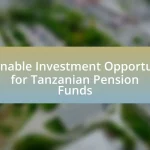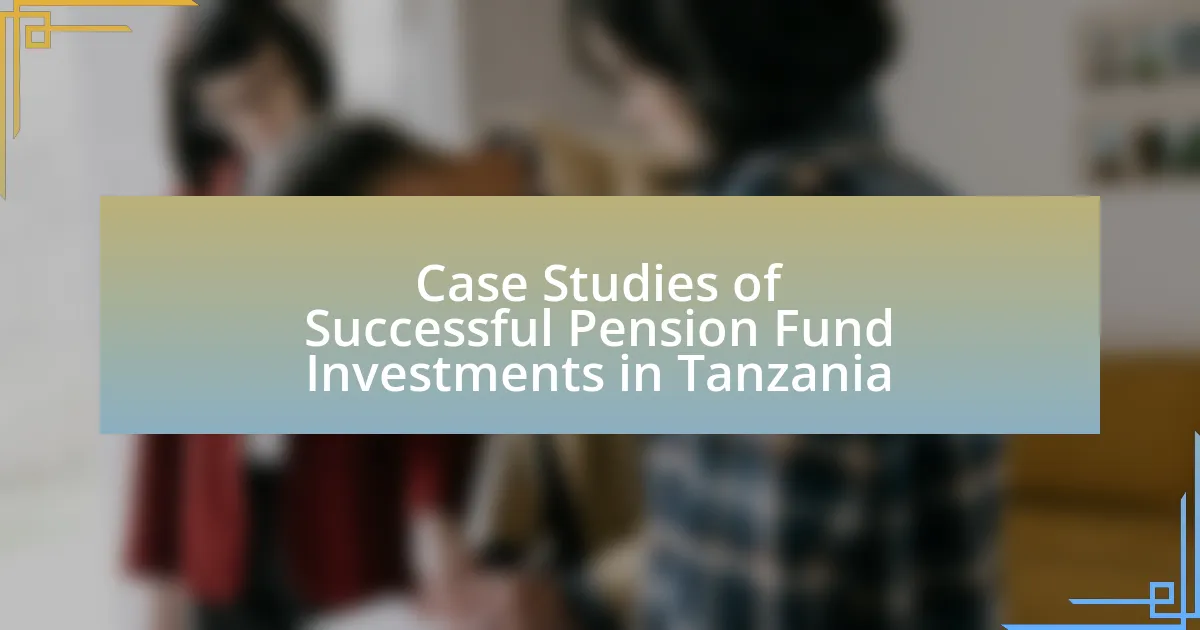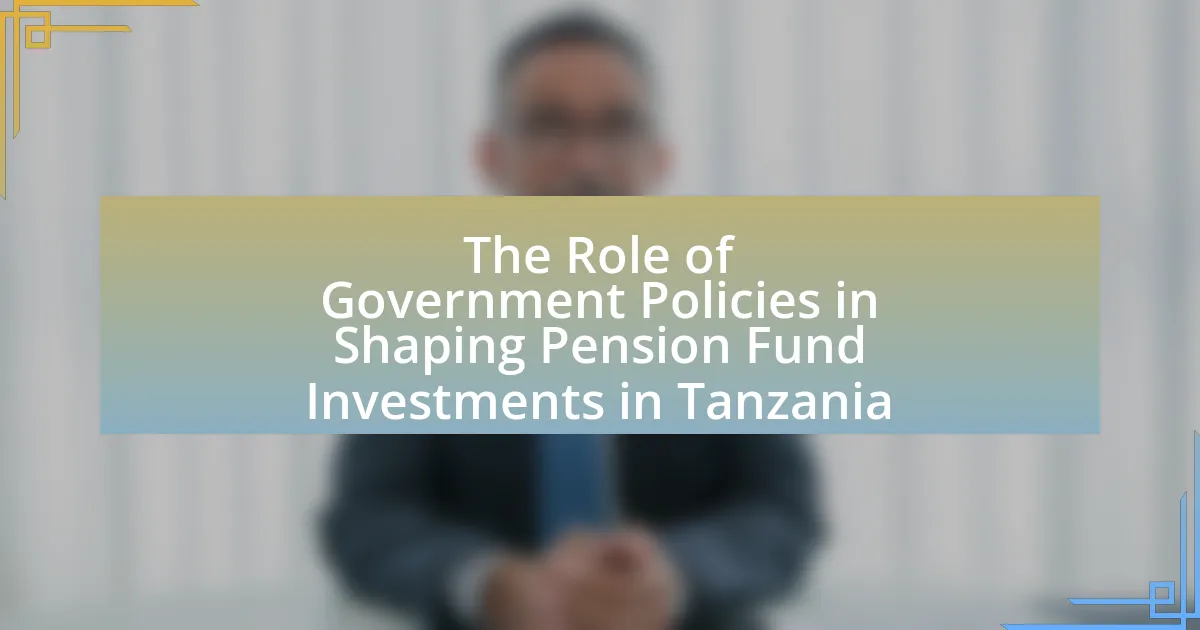The article focuses on the evolving landscape of technology investments for Tanzanian pension funds, highlighting current trends such as increased allocations to fintech solutions, digital asset management platforms, and renewable energy technologies. It examines how global technology investment trends are influencing local strategies, emphasizing the importance of diversification and innovation in enhancing returns. The article also addresses challenges faced by pension funds, including regulatory hurdles and market volatility, while outlining best practices for informed investment decisions. Additionally, it explores the potential impact of emerging technologies like artificial intelligence and blockchain on investment strategies, providing insights into the future outlook for technology investments in Tanzania.
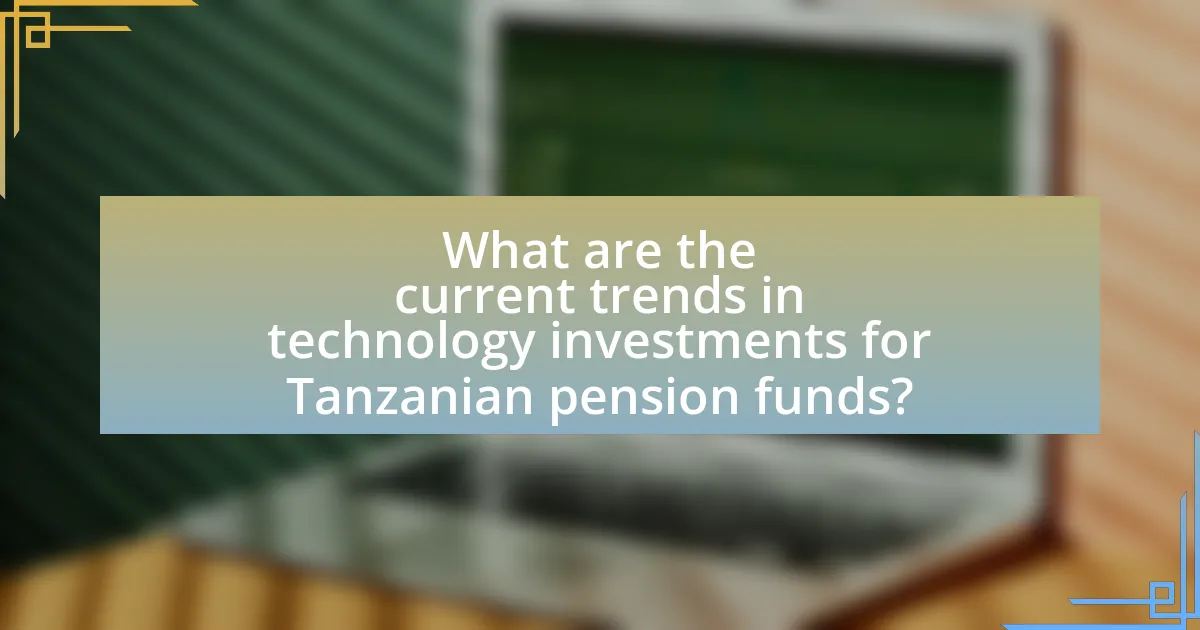
What are the current trends in technology investments for Tanzanian pension funds?
Current trends in technology investments for Tanzanian pension funds include a growing focus on fintech solutions, digital platforms for asset management, and investments in renewable energy technologies. Tanzanian pension funds are increasingly allocating resources to fintech startups that enhance financial inclusion and improve operational efficiency. For instance, the National Social Security Fund (NSSF) has been exploring partnerships with technology firms to streamline its services and expand its digital footprint. Additionally, there is a notable interest in investing in renewable energy projects, aligning with global sustainability goals and the Tanzanian government’s push for green energy initiatives. These trends reflect a strategic shift towards leveraging technology to optimize returns and manage risks effectively in the pension fund sector.
How are global technology investment trends influencing Tanzanian pension funds?
Global technology investment trends are significantly influencing Tanzanian pension funds by encouraging diversification into technology-driven assets. As global markets increasingly favor technology sectors, Tanzanian pension funds are reallocating investments towards tech startups and digital infrastructure to enhance returns. For instance, the rise of fintech and e-commerce in Africa has prompted pension funds to invest in local tech companies, aligning with the global shift towards digital transformation. This trend is supported by the African Development Bank’s report, which highlights that technology investments in Africa are projected to grow, thus providing a lucrative opportunity for pension funds to capitalize on emerging markets.
What specific technologies are attracting attention from pension funds in Tanzania?
Pension funds in Tanzania are increasingly focusing on renewable energy technologies, particularly solar and wind energy. This shift is driven by the need for sustainable investment opportunities that align with global trends towards environmental responsibility. According to the Tanzania Renewable Energy Association, investments in solar energy have seen a significant rise, with over 1,000 MW of solar projects planned or underway, indicating strong interest from institutional investors. Additionally, advancements in fintech, such as mobile banking and blockchain technology, are also attracting attention, as they offer innovative solutions for financial inclusion and efficiency in managing pension assets.
How do these global trends align with local investment strategies?
Global trends in technology investments, such as the rise of digital transformation and sustainable investing, align with local investment strategies of Tanzanian pension funds by encouraging diversification and innovation. Tanzanian pension funds are increasingly recognizing the importance of investing in technology sectors that drive economic growth, such as fintech and renewable energy, which are pivotal in addressing local challenges. For instance, the World Bank reported that digital financial services could significantly enhance financial inclusion in Tanzania, thus presenting a compelling case for pension funds to invest in technology-driven solutions that align with both global trends and local needs.
What challenges do Tanzanian pension funds face in technology investments?
Tanzanian pension funds face several challenges in technology investments, primarily including limited access to capital, inadequate regulatory frameworks, and a lack of skilled personnel. Limited access to capital restricts pension funds from investing in innovative technologies, as many funds operate under strict liquidity requirements. Inadequate regulatory frameworks hinder the ability of these funds to engage in technology investments, as existing regulations may not support or encourage such ventures. Additionally, the lack of skilled personnel in the technology sector makes it difficult for pension funds to assess and manage technology investments effectively, leading to potential misallocation of resources. These challenges collectively impede the growth and diversification of pension fund portfolios in Tanzania.
What regulatory hurdles impact technology investments for pension funds in Tanzania?
Regulatory hurdles impacting technology investments for pension funds in Tanzania include stringent compliance requirements, lack of clear investment guidelines, and limitations on foreign investment. The Pension Funds Act mandates that pension funds must adhere to specific investment limits and asset allocation rules, which can restrict their ability to invest in innovative technology sectors. Additionally, the absence of a comprehensive regulatory framework for technology investments creates uncertainty, making pension funds hesitant to allocate resources to emerging tech opportunities. These factors collectively hinder the potential for growth and diversification in pension fund portfolios within the Tanzanian technology landscape.
How do market volatility and economic conditions affect investment decisions?
Market volatility and economic conditions significantly influence investment decisions by altering risk perceptions and expected returns. When market volatility is high, investors often become more risk-averse, leading them to favor safer assets or to hold cash rather than invest in equities or other higher-risk investments. For instance, during periods of economic downturn, such as the 2008 financial crisis, many investors shifted their portfolios towards bonds and other low-risk securities, reflecting a preference for capital preservation over potential gains. Additionally, economic indicators like GDP growth, unemployment rates, and inflation can dictate investment strategies; strong economic performance typically encourages investment in growth sectors, while weak conditions may prompt a more conservative approach. Historical data shows that during the COVID-19 pandemic, many pension funds reassessed their allocations, increasing their holdings in technology and healthcare sectors, which were perceived as more resilient.
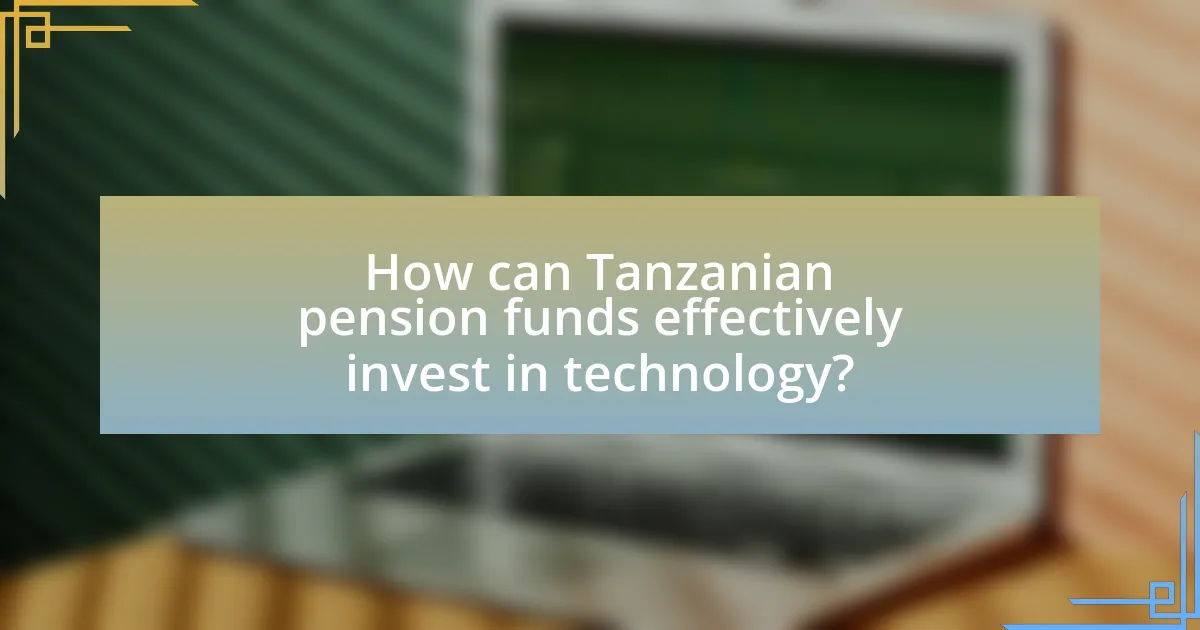
How can Tanzanian pension funds effectively invest in technology?
Tanzanian pension funds can effectively invest in technology by diversifying their portfolios to include technology startups and established tech companies, leveraging local and international venture capital opportunities. This approach allows pension funds to capitalize on the growing technology sector in Tanzania, which has seen a significant increase in digital innovation and mobile technology adoption, with the country experiencing a 30% annual growth in the tech industry over the past five years. Additionally, collaborating with technology incubators and accelerators can provide pension funds with access to emerging technologies and innovative business models, enhancing their investment strategies and potential returns.
What strategies should pension funds adopt for technology investments?
Pension funds should adopt a diversified investment strategy focused on emerging technologies, such as artificial intelligence, blockchain, and renewable energy. This approach allows pension funds to mitigate risks while capitalizing on high-growth sectors. For instance, according to a report by McKinsey, investments in technology-driven sectors have outperformed traditional sectors by an average of 3-5% annually over the past decade. Additionally, pension funds should engage in partnerships with technology firms and venture capitalists to gain insights and access to innovative startups, enhancing their investment portfolios. By leveraging data analytics, pension funds can also make informed decisions based on market trends and performance metrics, further optimizing their technology investments.
How can diversification mitigate risks in technology investments?
Diversification mitigates risks in technology investments by spreading capital across various sectors, companies, and technologies, thereby reducing exposure to any single investment’s volatility. This strategy is particularly effective in the technology sector, which is characterized by rapid changes and uncertainties. For instance, a study by the CFA Institute indicates that a diversified portfolio can reduce risk by up to 30% compared to a concentrated investment approach. By investing in a mix of established tech firms, startups, and different technological domains, investors can buffer against market fluctuations and sector-specific downturns, leading to more stable returns over time.
What role do partnerships with tech firms play in investment success?
Partnerships with tech firms significantly enhance investment success by providing access to innovative technologies, expertise, and market insights. These collaborations enable pension funds to leverage cutting-edge solutions that improve operational efficiency and investment strategies. For instance, a study by McKinsey & Company indicates that organizations that engage in strategic partnerships with technology companies can achieve up to 20% higher returns on investment due to improved data analytics and decision-making capabilities. This evidence underscores the critical role that such partnerships play in optimizing investment outcomes for entities like Tanzanian pension funds.
What are the potential returns on technology investments for pension funds?
Technology investments for pension funds can yield returns ranging from 7% to 15% annually, depending on market conditions and the specific technologies invested in. For instance, investments in fintech and health tech have shown significant growth, with the global fintech market projected to reach $460 billion by 2025, reflecting a compound annual growth rate (CAGR) of 25%. Additionally, a study by McKinsey & Company indicates that technology-driven companies tend to outperform traditional sectors, providing pension funds with opportunities for higher returns. These figures demonstrate the potential for substantial financial gains through strategic technology investments.
How do technology investments compare to traditional asset classes in terms of returns?
Technology investments generally outperform traditional asset classes in terms of returns. For instance, over the past decade, technology stocks have delivered average annual returns exceeding 20%, while traditional asset classes like bonds and real estate have typically yielded around 5-8% annually. This trend is supported by data from the S&P 500, where technology sector companies have consistently led in growth, driven by innovation and market demand. Additionally, a report by McKinsey & Company highlights that technology-driven companies are more likely to achieve higher revenue growth rates compared to their non-tech counterparts, reinforcing the superior return potential of technology investments.
What metrics should be used to evaluate the performance of technology investments?
To evaluate the performance of technology investments, key metrics include Return on Investment (ROI), Total Cost of Ownership (TCO), and Net Present Value (NPV). ROI measures the profitability of an investment relative to its cost, providing a clear indication of financial return. TCO accounts for all direct and indirect costs associated with the technology over its lifecycle, ensuring a comprehensive understanding of financial impact. NPV calculates the present value of future cash flows generated by the investment, allowing for comparison against initial costs. These metrics are essential for informed decision-making regarding technology investments, particularly in the context of Tanzanian pension funds, where maximizing returns while managing risks is crucial.

What is the future outlook for technology investments in Tanzanian pension funds?
The future outlook for technology investments in Tanzanian pension funds is promising, driven by increasing digitalization and the need for improved operational efficiency. Tanzanian pension funds are expected to allocate more resources towards fintech solutions, which can enhance portfolio management and customer engagement. According to a report by the World Bank, the adoption of technology in financial services can lead to a 30% reduction in operational costs, making it an attractive option for pension funds seeking to optimize their investments. Additionally, the Tanzanian government’s support for digital infrastructure development further reinforces the potential for technology investments in this sector.
How will emerging technologies shape the investment landscape for pension funds?
Emerging technologies will significantly reshape the investment landscape for pension funds by enhancing data analytics, improving risk management, and enabling more efficient asset allocation. For instance, the integration of artificial intelligence and machine learning allows pension funds to analyze vast amounts of data quickly, leading to more informed investment decisions. According to a report by Deloitte, 80% of institutional investors believe that AI will transform their investment strategies within the next five years. Additionally, blockchain technology offers transparency and security in transactions, which can reduce fraud and operational costs. As these technologies continue to evolve, pension funds will likely adopt them to optimize their portfolios and meet the growing demands of beneficiaries.
What impact will artificial intelligence and blockchain have on investment strategies?
Artificial intelligence and blockchain will significantly enhance investment strategies by improving data analysis, increasing transparency, and reducing transaction costs. AI algorithms can analyze vast datasets to identify trends and optimize portfolio management, leading to more informed investment decisions. For instance, a study by McKinsey & Company found that AI can increase investment returns by up to 15% through better risk assessment and predictive analytics. Meanwhile, blockchain technology ensures secure and transparent transactions, which can lower operational risks and costs associated with traditional investment processes. According to a report by Deloitte, blockchain can reduce transaction costs by up to 30% in financial services, making it a valuable tool for pension funds looking to maximize returns while minimizing expenses.
How can pension funds prepare for future technological disruptions?
Pension funds can prepare for future technological disruptions by investing in technology-focused assets and enhancing their digital infrastructure. By allocating a portion of their portfolios to emerging technologies such as artificial intelligence, blockchain, and renewable energy, pension funds can capitalize on growth opportunities while mitigating risks associated with technological changes. For instance, a report from McKinsey indicates that companies adopting advanced technologies can increase productivity by up to 30%. Additionally, pension funds should prioritize developing robust cybersecurity measures to protect their assets and data from potential threats, as cyberattacks have increased by 400% since the onset of the COVID-19 pandemic, according to the FBI. This proactive approach will enable pension funds to remain resilient and competitive in a rapidly evolving technological landscape.
What best practices should Tanzanian pension funds follow for technology investments?
Tanzanian pension funds should prioritize diversification, due diligence, and alignment with long-term investment goals when making technology investments. Diversification across various technology sectors can mitigate risks associated with market volatility, as evidenced by the performance of diversified portfolios during economic downturns. Conducting thorough due diligence ensures that funds assess the financial health, market position, and growth potential of technology companies before investing, which is crucial given the rapid evolution of the tech landscape. Additionally, aligning technology investments with long-term goals, such as sustainability and innovation, can enhance returns and support the overall mission of pension funds to secure retirement benefits for members.
How can pension funds ensure they are making informed investment decisions?
Pension funds can ensure they are making informed investment decisions by implementing rigorous due diligence processes and utilizing data analytics. These funds should conduct thorough research on potential investments, including financial performance, market trends, and risk assessments. For instance, a study by the CFA Institute highlights that 70% of investment professionals believe that data-driven decision-making enhances investment outcomes. Additionally, pension funds can leverage technology tools, such as predictive analytics and machine learning, to analyze vast amounts of data efficiently, allowing for more accurate forecasting and risk management. By combining traditional investment analysis with advanced technological solutions, pension funds can significantly improve their decision-making processes.
What resources are available for pension funds to stay updated on technology trends?
Pension funds can utilize industry reports, technology-focused financial news platforms, and specialized conferences to stay updated on technology trends. Industry reports from organizations like Deloitte and McKinsey provide insights into emerging technologies and their implications for investment strategies. Financial news platforms such as Bloomberg and Financial Times offer real-time updates and analyses on technology market trends. Additionally, attending conferences like the Pension Fund Investment Summit allows pension fund managers to network with technology experts and gain firsthand knowledge of innovations impacting the investment landscape. These resources collectively ensure that pension funds remain informed about technological advancements that could influence their investment decisions.

